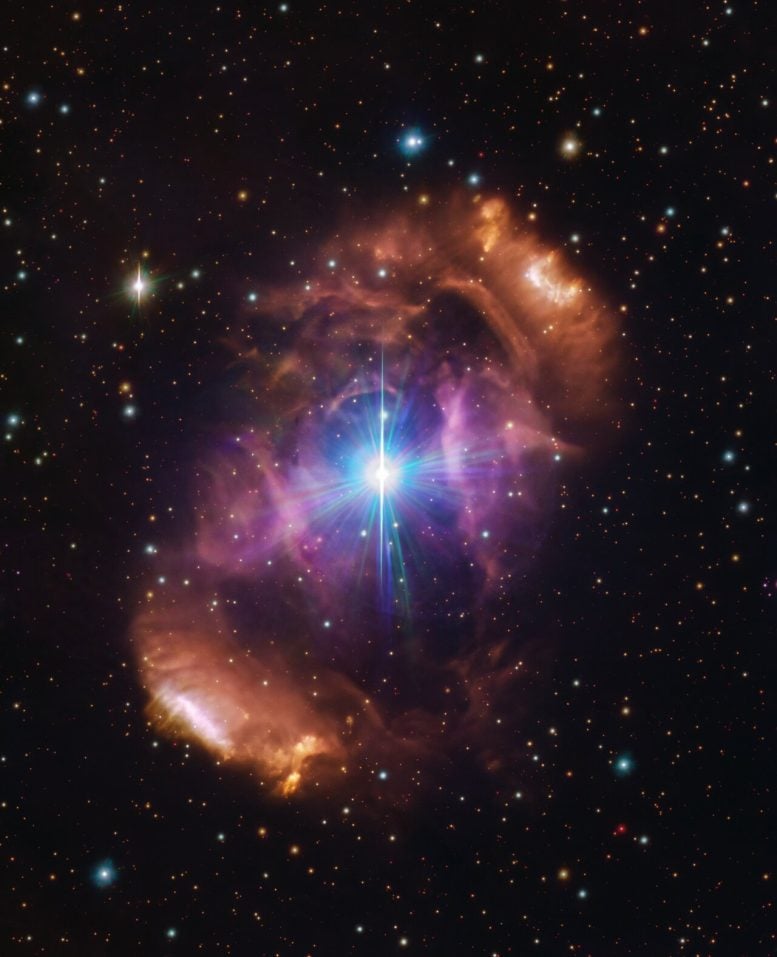
Astronomers at the European Southern Observatory have revealed that the peculiar characteristics of the HD 148937 star system, including a magnetic star and its young appearance, are due to the merger of two stars from an original group of three. This event also formed the surrounding nebula, providing crucial evidence on how massive stars can develop magnetic fields.
When astronomers looked at a stellar pair at the heart of a stunning cloud of gas and dust, they were in for a surprise. Star pairs are typically very similar, like twins, but in HD 148937, one star appears younger and, unlike the other, is magnetic. New data from the European Southern Observatory (ESO) suggest there were originally three stars in the system, until two of them clashed and merged. This violent event created the surrounding cloud and forever altered the system’s fate.
“When doing background reading, I was struck by how special this system seemed,” says Abigail Frost, an astronomer at ESO in Chile and lead author of the study published in Science. The system, HD 148937, is located about 3800 light-years away from Earth in the direction of the Norma constellation. It is made up of two stars much more massive than the Sun and surrounded by a beautiful nebula, a cloud of gas and dust. “A nebula surrounding two massive stars is a rarity, and it really made us feel like something cool had to have happened in this system. When looking at the data, the coolness only increased.”
“After a detailed analysis, we could determine that the more massive star appears much younger than its companion, which doesn’t make any sense since they should have formed at the same time!” Frost says. The age difference — one star appears to be at least 1.5 million years younger than the other — suggests something must have rejuvenated the more massive star.
The Nebula and Its Secrets
Another piece of the puzzle is the nebula surrounding the stars, known as NGC 6164/6165. It is 7500 years old, hundreds of times younger than both stars. The nebula also shows very high amounts of nitrogen, carbon, and oxygen. This is surprising as these elements are normally expected deep inside a star, not outside; it is as if some violent event had set them free.
To unravel the mystery, the team assembled nine years’ worth of data from the PIONIER and GRAVITY instruments, both on ESO’s Very Large Telescope Interferometer (VLTI), located in Chile’s Atacama Desert. They also used archival data from the FEROS instrument at ESO’s La Silla Observatory.
Merging Stars and Magnetic Mysteries
“We think this system had at least three stars originally; two of them had to be close together at one point in the orbit whilst another star was much more distant,” explains Hugues Sana, a professor at KU Leuven in Belgium and the principal investigator of the observations. “The two inner stars merged in a violent manner, creating a magnetic star and throwing out some material, which created the nebula. The more distant star formed a new orbit with the newly merged, now-magnetic star, creating the binary we see today at the center of the nebula.”
“The merger scenario was already in my head back in 2017 when I studied nebula observations obtained with the European Space Agency’s Herschel Space Telescope,” adds co-author Laurent Mahy, currently a senior researcher at the Royal Observatory of Belgium. “Finding an age discrepancy between the stars suggests that this scenario is the most plausible one and it was only possible to show it with the new ESO data.”
This scenario also explains why one of the stars in the system is magnetic and the other is not — another peculiar feature of HD 148937 spotted in the VLTI data.
At the same time, it helps solve a long-standing mystery in astronomy: how massive stars get their magnetic fields. While magnetic fields are a common feature of low-mass stars like our Sun, more massive stars cannot sustain magnetic fields in the same way. Yet some massive stars are indeed magnetic.
Astronomers had suspected for some time that massive stars could acquire magnetic fields when two stars merge. But this is the first time researchers have found such direct evidence of this happening. In the case of HD 148937, the merger must have happened recently. “Magnetism in massive stars isn’t expected to last very long compared to the lifetime of the star, so it seems we have observed this rare event very soon after it happened,” Frost adds.
Reference: “A magnetic massive star has experienced a stellar merger” by A. J. Frost, H. Sana, L. Mahy, G. Wade, J. Barron, J.-B. Le Bouquin, A. Mérand, F. R. N. Schneider, T. Shenar, R. H. Barbá, D. M. Bowman, M. Fabry, A. Farhang, P. Marchant, N. I. Morrell and J. V. Smoker, 11 April 2024, Science.
DOI: 10.1126/science.adg7700
ESO’s Extremely Large Telescope (ELT), currently under construction in the Chilean Atacama Desert, will enable researchers to work out what happened in the system in more detail, and perhaps reveal even more surprises.
It has received funding from the European Research Council (ERC) under the European Union’s Horizon 2020 research and innovation program (grant agreement number 772225: MULTIPLES; PI: Hugues Sana).
Never miss a breakthrough: Join the SciTechDaily newsletter.
1 Comment
Those folks are easily shocked.